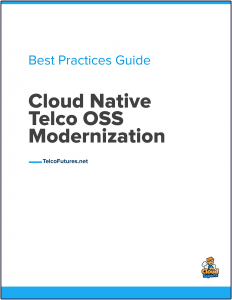Microsoft Azure Solutions and Architecture for Cloud Native OSS Modernization
Microsoft Azure for Telecommunications, with its comprehensive suite of cloud-native tools and services, provides a robust platform for modernizing OSS.
 The telecommunications industry is undergoing a profound transformation, driven by the demands of 5G, edge computing, and the Internet of Things (IoT).
The telecommunications industry is undergoing a profound transformation, driven by the demands of 5G, edge computing, and the Internet of Things (IoT).
Traditional operational support systems (OSS), built on monolithic, legacy architectures, are increasingly inadequate for handling the scale, agility, and complexity of modern telecom networks.
Cloud-native OSS modernization offers telecom operators a path to overcome these limitations by leveraging flexible, scalable, and automated architectures.
Microsoft Azure for Telecommunications, with its comprehensive suite of cloud-native tools and services, provides a robust platform for modernizing OSS, enabling operators to enhance operational efficiency, accelerate service delivery, and support innovative use cases like network slicing and real-time analytics.
Microservices Architecture and Azure Kubernetes Service
At the heart of cloud-native OSS modernization on Azure lies a microservices-based architecture, which decomposes traditional monolithic OSS into smaller, independent services.
Azure supports this transformation through services like Azure Kubernetes Service (AKS), a managed Kubernetes platform that simplifies the deployment, management, and scaling of containerized OSS applications. AKS enables telecom operators to package OSS components—such as inventory management, fault monitoring, or service orchestration—into containers using Docker, ensuring portability and consistency across hybrid and multi-cloud environments.
By orchestrating these containers, AKS provides auto-scaling to handle dynamic network workloads, self-healing to maintain uptime during failures, and load balancing to optimize performance. For example, a telecom operator could deploy a containerized fault management system on AKS to automatically scale during network outages, ensuring uninterrupted monitoring for 5G services. Azure’s support for microservices aligns with the need for modular, loosely coupled systems that can be updated independently, reducing time-to-market for new features and improving operational agility.
Azure DevOps
Complementing AKS, Azure DevOps plays a pivotal role in fostering a collaborative and automated development lifecycle for cloud-native OSS. Azure DevOps enables continuous integration and continuous deployment (CI/CD) pipelines, which automate the testing, integration, and rollout of OSS updates, allowing operators to rapidly deploy enhancements with minimal manual intervention.
For instance, an operator might use Azure DevOps to streamline updates to a cloud-native service assurance platform, ensuring seamless integration with a 5G core for real-time network slicing. Tools like Azure Pipelines and Azure Repos support version control and automated workflows, while Azure Monitor provides end-to-end observability, enabling operators to track performance and detect issues proactively.
By integrating AI-powered tools like GitHub Copilot, Azure DevOps further accelerates development by automating routine coding tasks, enhancing developer productivity. This combination of automation and collaboration ensures that OSS can evolve in lockstep with emerging telecom demands, such as IoT-driven data surges or edge computing applications.
API Open Standards
Azure’s API-first design capabilities are critical for enabling interoperability in cloud-native OSS. Azure API Management allows operators to publish, secure, and manage APIs that connect OSS components with network functions, business support systems (BSS), and external platforms.
By adopting standards like TM Forum’s Open APIs, operators can ensure seamless integration across diverse systems, supporting use cases like dynamic network slicing or IoT device management. For example, a cloud-native OSS deployed on Azure could use API Management to integrate a service orchestration module with a 5G core, enabling real-time configuration of network resources.
Additionally, Azure Arc extends these capabilities to hybrid and multi-cloud environments, allowing operators to manage Kubernetes clusters and data services across on-premises, edge, and cloud infrastructure from a single control plane. This unified approach ensures consistent governance and operational efficiency, particularly for telecom operators with distributed network assets.
AI and Automation
Automation and AI integration are transformative for cloud-native OSS on Azure. Azure’s AI and machine learning services, such as Azure Machine Learning and Azure Cognitive Services, enable predictive maintenance, anomaly detection, and automated root-cause analysis, reducing operational overhead and improving network reliability.
For instance, an AI-powered OSS could predict network congestion and automatically reroute traffic to optimize performance, a critical capability for 5G networks.
Azure Arc-enabled data services further enhance this by centralizing operational data for AI-driven decision-making across distributed environments. Infrastructure-as-code (IaC) tools like Azure Resource Manager and Azure Bicep allow operators to automate the provisioning and configuration of OSS infrastructure, ensuring consistency and repeatability. These capabilities align with the telecom industry’s push toward zero-touch operations, where manual intervention is minimized, and systems self-optimize in real time.
Azure’s hybrid and multi-cloud capabilities make it an ideal platform for telecom operators with complex, distributed infrastructures. Azure Arc enables operators to manage Kubernetes clusters, virtual machines, and databases across on-premises, edge, and multi-cloud environments, providing a unified data foundation for OSS modernization. This is particularly valuable for telecom operators transitioning from legacy systems, as Azure Arc supports gradual modernization by integrating on-premises infrastructure with cloud-native services.
Azure’s pay-as-you-go pricing model, combined with autoscaling and reserved instances, optimizes costs by ensuring resources are allocated dynamically based on demand. For example, an operator could use Azure Arc to deploy a cloud-native inventory management system at the edge for low-latency IoT applications, while hosting analytics workloads in the cloud to leverage Azure’s scalable compute resources.
Leadership Case Studies
Real-world examples demonstrate Azure’s impact on cloud-native OSS modernization. For instance, AT&T has leveraged Azure OpenAI capabilities to modernize its 5G network operations, achieving faster service deployment and improved reliability.
Similarly, Vodafone has used Azure DevOps API Management and AKS to streamline its OSS for 5G network slicing, enabling dynamic resource allocation. Rakuten Mobile, a greenfield operator, built a fully cloud-native OSS stack on Azure, utilizing AKS and Azure Arc to achieve unprecedented agility and cost efficiency. These cases highlight Azure’s ability to support telecom operators in transitioning to cloud-native OSS, delivering the scalability and flexibility needed for next-generation networks.
Looking ahead, Azure’s roadmap for cloud-native OSS modernization aligns with emerging telecom trends. Azure IoT Operations, enabled by Azure Arc, supports edge-native OSS for low-latency applications like autonomous vehicles or augmented reality, processing data at the edge in near real-time. AI-native OSS, powered by Azure’s AI portfolio, will enable real-time decision-making and zero-touch operations, while Azure’s focus on sustainability supports energy-efficient OSS deployments.
Open ecosystems, leveraging Azure’s integration with open-source tools and industry standards like MQTT and OpenTelemetry, will drive collaboration and innovation. As telecom operators navigate the complexities of 5G, IoT, and edge computing, Azure’s comprehensive solutions—spanning AKS, DevOps, API Management, AI, and hybrid capabilities—position it as a leading platform for cloud-native OSS modernization.
Conclusion
In conclusion, Microsoft Azure provides a powerful and flexible platform for modernizing telecom OSS, enabling operators to transition from legacy systems to agile, scalable, and automated architectures. By leveraging AKS for containerization, Azure DevOps for CI/CD, API Management for interoperability, and AI for automation, operators can address the demands of modern networks while optimizing costs and resilience.
While challenges like legacy integration and skill gaps exist, Azure’s migration tools, security features, and training resources provide a clear path forward. As the telecommunications industry evolves, Azure’s cloud-native solutions will empower operators to deliver innovative, customer-centric services, ensuring competitiveness in a rapidly changing landscape.



